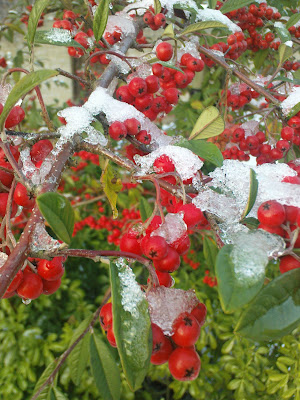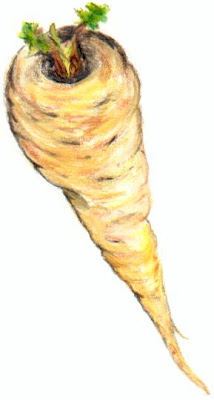Whilst the whole of the Great British Island is coming to a hault under an inch of snow, the ingenious population is resorting to warming stews and increasingly intoxicating pints. Russians - local and otherwise - drink vodka (clichés are so necessary and so sexy) and eat fat-laden cubes of potatoes, meat and veg.

The
Olivier salad - the glorious and (in?) famous Russian potato salad, created by a French chef in the tsarist Russia, and then eaten en messe by the 1/6 of the planet for the next century, is now consumed throughout the world, in different shapes and versions. When the winter comes with its culmination at the New Year's eve, Russians of all shapes and sizes think 'potato', 'mayonnaise', 'cubes' and start chopping. Here's the story of the little, but not that humble, Potato salad.
The significance of chopping at New Year's EveChopping is precisely what I got to doing with my Russian champs the other night. No matter how many years we have spent away from the Mother Russia, end of December will always mean one thing and one thing only -
New Year's Eve and Olivier. NYE in Russia is a curious combination of Western Christmas family traditions (kids and old are all there) and the debauchery of NYE partying proper (drink, drink, drink). Why this day, and night, got alleviated to such a level is easy to explain - the big USSR did not want to celebrate Christmas (25 Dec or 6 Jan as per Russian Orthodox calender) for the obvious, atheist reasons, but people still had that ingrained, pagan need to mark the winter solstice, fight off the dark ghosts of winter and hope for the future. Now Russia is free to celebrate whatever it likes, but
31 December is still the biggest and the most awaited day of the year.
Olivier and its potatoes are the heroes of the night.
 Why potato? Why salad?
Why potato? Why salad?Well, the significance of tightly chopped vegetables for the Russian physic would certainly be an interesting one to explore for my next Phd in psychiatry:), but for now let's just say the good old
Peter the Great did well back in 17the century by bringing the scraggy tuber to Russia from his explorations in the Netherlands (being clean-shaven and eating potatoes became somewhat the thing a la mode). Now Russia is the biggest producer of potatoes in the world (after China, surprise?) and each Ruski is consuming nearly 150 kg of potatoes a year (are you dividing the figure by 52?!).
And let's not forget that some of the best vodka is made out of potatoes.
The link to the Dutch is not accidental - Van Gogh, with his ears still intact, drew this scaringly beautifully and ugly painting called '
The Potato Eaters'.

Incredible to think that just a century after Peter's travels, potato had already become the vegetable associated with the most trivial, dumb and belly-filling. I love the way their faces look like the bulbous potatoes themselves, hands are knobbly, rough; they are the off-spring of the tuber, all looking the same, no gender, spark or wit. Potato was not the
piece de resistance of the most forward any longer...
What about the Salad??About the same time when Van Gogh was vaxing less than lyrically about the potato, a French chef called
Lucien Olivier (a seriously flirtatious type, according to some) was re-i
nventing it in The Hermitage, one of Moscow's most celebrated restaurants. The original salad was rather different from the contemporary version and included amongst other ingredients hazel-grouse, veal tongue, caviar, capers and mayonnaise Provençal - a heady sauce of yolks and olive oil that the young Lucien had brought from his home-land.The legend has it that one of his understudies had stolen the recipe for the sauce and started making a version of the salad in another Moscow restaurant, naming the concossion 'Stolichnyj salad', or The Capital Salad' (the name still widely found in all sorts of Russian eateries). Over time, the salad had gone through the inevitable bourgeoisition
(such a word?) process and is now using either chicken or ham or even frankfurter type sausage, tinned peas, boiled carrot and eggs, mayo out of the tub and, of course, boiled potatoes. Here's my version - a slightly trendified Olivier one might say:)
 Olivier Salad
Olivier SaladRemember - you can put anything into this salad, in whatever quantities, as long as you have:
1. potatoes, some kind of meat and mayonnaise
2. potatoes should be about twice the weight of the rest of the ingredients
You'll need:
1 small chicken (organic is preferable of course, but free-range is a must) plus a quartered onion, a halfed carrot, a couple of bay leaves and a few peppercorns
4 v. large potatoes
2 medium carrots
2 eggs
a handful of peas, frozen
2 tbsp capers
1 tart apple
salted cucumbers (marinated will do too, but too sweet for my liking; go for the Israeli type - if concious permits - the ones on sale in Sainsburys have the right salty tang). NB: keep the brine.
1 onion
about 350ml of mayonnaise - home-made is less 'authentic', but makes a lot of difference. you'll need:
2 (organic..) yolks
1/4 tsp salt
1/4 Dijon mustard
1 tbp white wine vinegar or lemon juice
225 ml vegetable oil
I use
Darina Allen's recipe for making my mayo.
You will need to start making the salad at least on the eve of your feast.
1. Put your chicken whole into a big saucepan, cover with cold water, add your stock veg, bring to the boil, and then simmer until fully cooked, for at least an hour. do not dare to throw out your stock - use it to make beautiful
borsch.
2. Put washed but unpeeled potatoes into a saucepan and boil until fully cooked. Some 10 mins before they are cooked (when the knife is getting through the flesh with some difficulty still) add the carrots to boil.
3. Whilst potatoes are preparing themselves, boil your eggs until fully cooked, but not blue, 7-8 mins. Briefly cook your peas.
4. Leave everything to cool completely, perhaps until the following morning.
5. Peel the veg above, as well as your onion and an apple. Shred your chicken of the bones, discarding skin (although I eat it with crystals of salt).
6. Get chopping. I like it small, really small - the size of my small fingernail - but others prefer it big and chunky. Everything goes into one big bowl. Mix gently and season lightly.
7. Make your mayonnaise or just unscrew your jar. and
now is the most important thing - start adding half of your mayonnaise and then a few spoons at a time and taste, taste and taste. Add more mayonnaise, more cucumbers, capers, onions - whatever you think is missing.
Olivier is like a good Asian dish, it has layers of flavours: tart, pickled, salty, sweet, all married by the powerful mayonnaise. Who said Russian food was boring and one-dimensional?
8. Remember you left behind some brine from your cucumbers? add a bit to your mix, perhaps 2-3 tbp. it adds that je ne c'est quoa.
9. Sprinkle with dill if desired and eat in big gulps with chunks of good and sweet Russian rye bread.
Na zdorovye and s novym godom!p.s. a short of lip-numbingly cold vodka - potato or otherwise - is very satisfying with Olivier.




